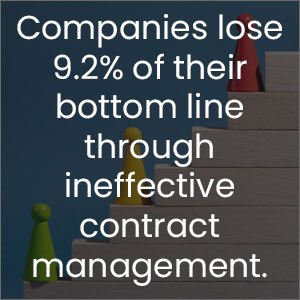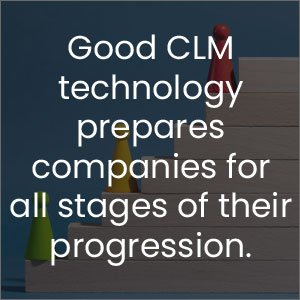There are many concerning, and even alarming stats about the contract management needs of businesses. Analyst, research publications, and associations tell us that our current practices are simply not up to snuff. Rather, too many of our in-house legal and legal operations teams are still using old-school practices, systems, and techniques for their agreements management.
As an example, in relation to contract management being handled manually, some of the statistics that should alarm you are:
- The average Fortune 2000 company has about 20,000 – 40,000 active contracts at any given time
- Companies lose 9.2% of their bottom line through ineffective contract management
- By 2023, 40% of I&O teams will use AI-augmented automation in large enterprises, resulting in higher IT productivity with greater agility and scalability
They point us in one general direction. Organizations have significant contract management needs. This is to enable legal departments to better handle risk management, draft more standardized contracts, speed up the system by going digital (ie: electronic signatures), and so on.
But do all companies have the same contract management needs?
Of course, the answer is No. The state of contract management processes in companies varies. So does their maturity phase, which defines their needs. From research, analyst discussions, and direct customer contact, three models emerge, which I will discuss below.
INDUSTRY CHALLENGES
Today’s estimates are that anywhere from 55% – 70% of organizations DO NOT have effective contract management systems. Paired with the idea that companies typically have thousands of active contracts – this is frightful! How can you minimize risks while juggling so many agreements and contract types, without a good system to help? Good CLM technology prepares companies for all stages of their progression.
Surprisingly, many companies have no more than a simple process for capturing contracts and storing them. Often, this still includes paper copies stored in filing cabinets. This partnered with a spreadsheet to track them. Others don’t even have an established process. That means agreements are printed in file folders on employee desks, on thumb drives (USB sticks), network servers, Sharepoint portals, on the cloud (DropBox), and other places.
“In the U.S, contract disputes represent 64% of cases in state courts, making it imperative that organizations know where their contracts are located” (Gartner 2019). So, when a contract dispute arises, are you sure you can find the executed contract in question? Were the contract terms and conditions within reason, and in line with your company’s expectations? Do you feel prepared to argue the case – if you cannot even find the agreement?
THE 3 STAGES OF CONTRACT MATURITY:
1. NEOPHYTES
In terms of contract management needs, neophytes (those new to the subject), often have straightforward, basic requirements. Most in this category are new to contract management software. Despite years of experience working with contracts, they may not have developed best practices in their processes, either.
At this first stage, customers often start with needing a single source, contract repository. This immediately fixes the challenge of NOT being able to find the complex contracts, when a question arises. There may be a need for obligation management, standardizing certain terms and conditions, creating agreement templates, and taking on a tool that helps to quickly draft (author) a new agreement.
When looking for a contract lifecycle management (CLM) system, look for these parts as standard starting points.
2. EARLY ADOPTERS
Early adopters are companies that deployed and have used first-generation CLM systems. Often these systems were focused on procurement agreement systems. Most often, these older systems have been on-premise technologies run by the IT team, with the occasional software patch and upgrade.
Early adopters have gone through a wave of project management for deployments years earlier. They will have a reasonably good agreement management process, outlining how things are done, authority for different stages and agreement types, and management roles in the process.
Contract management needs of this group often focus on finding the system with the functionality of their early solutions, plus more. Companies at this stage start to expand their scope of needs. So, it becomes even more important to look into the full gamut of contracts, like the sell side, NDA’s, IP contracts, partnerships, co-op agreements, and employee contracts, just to name a few. Today’s market really needs contract agnostic systems. By contract agnostic, I refer to systems that do not just cater to buy-side or sell-side deals but considers all contract types.
- Early Adopter System Needs
Ease of use and an easy and intuitive user interface (UI) becomes increasingly important. After all, as agreement management expands in the organization, more and more users will need access. Easy to understand UI’s encourages good adoption of the system.
At this phase, there is a greater focus on the automation capabilities, negotiation elements, some analytics, and cloud technology support. Artificial intelligence (AI) is important here to help create important contract snapshots (meta-tagging, extracted summaries), and start getting a view of the overall contracts landscape for the company.
3. MATURE USERS
Companies that are mature users have more sophisticated contract management needs. Here the focus is on risk management elements (identifying liabilities, obligations, and outliers), and heavier use of AI for contract analytics. In essence, it gives the office of the general counsel and the commercial contract managers a pulse on their business and agreements.
Mature stage users focus on having a measured, and controlled agreements process. Beyond that, mature stage companies focus on process improvement. Hence, using AI technologies to scan through all their contracts to pull out unusual obligations, serious risk liabilities, and indemnities. Also, this lets mature users standardize clauses, guide the efforts of legal counsel to adjust certain terms and conditions, and focus on risk management aspects. It makes for a more structured agreements management approach.
CONTRACT MANAGEMENT NEEDS
Contract management needs vary widely with different companies. The three stages identified as neophytes, early adopters, and mature users – are the three major clusters that characterize today’s landscape. It shows that there are many stages to the digital transformation journey. Also, it emphasizes that different companies are at different points along their trek. But, regardless of the maturity stage, there is a clear and distinct need for good contract lifecycle management technology – to help along the way.
Being in business today without a CLM is akin to going mountain climbing without a backpack filled with the RIGHT supplies to help you.
Good CLM technology prepares companies for all stages of their progression. Companies need end-to-end contract functionality. An AI engine that only provides front-end support only gives you a snapshot view of contracts or only provides backend analytics, is just not enough. Rather, you need the right CLM that gives you full coverage, with AI technology embedded throughout the solution.
For a deeper look at several critical aspects that your CLM should include, read our blog on ‘4 Core Reasons You Need An End-to-End CLM.’ Otherwise, feel free to connect with us at ContractPodAi for a pressure-free conversation about your needs and how we can help. If you are looking for a contract solution that helps lawyers, what better option than a system built by lawyers?
Author:

Sarvarth Misra
Connect with us on Linkedin





